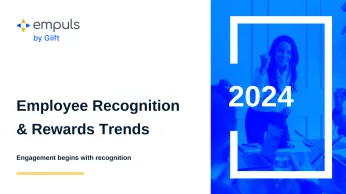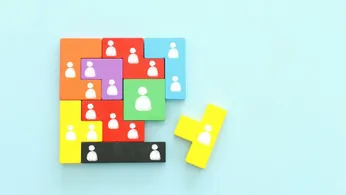في هذه الصفحة
- What is recognition?
- ما هو الامتنان؟
- Why is it important to create a culture of recognition and gratitude in the workplace?
- Benefits of building a culture of recognition and gratitude in your workplace
- 10 Ways to create a culture of recogniton and gratitude in the workplace
- How Empuls fuels a culture of recognition and gratitude
Imagine walking into work every day knowing your contributions matter—that your effort isn’t just noticed, but genuinely appreciated. That’s the power of a culture of recognition and appreciation.
And it couldn’t be more relevant today. In a recent survey by McKinsey, 40% of employees reported they were likely to leave their current job in the next 3–6 months, as the Great Resignation shows no signs of slowing down. Employees are no longer just chasing paychecks—they’re seeking purpose, belonging, and to feel valued in their work.
This is where building a culture of gratitude becomes your secret weapon. It’s not about one-off perks or token gestures. It’s about making gratitude and recognition a daily ritual—woven into the way teams collaborate, celebrate, and grow together.
So, how do you create a culture of recognition that doesn’t feel forced or forgotten? One that energizes people, boosts retention, and inspires them to do their best work?
This blog is your blueprint. Let’s explore why recognition and gratitude matter more than ever—and how to make them the heartbeat of your workplace culture.
What is recognition?
Recognition, in general, is acknowledging all the positive things in life, such as the goodness in other people, events, and experiences. Employee recognition acknowledges employees' inherent value, not just their work performance.
Building a culture of recognition involves acknowledging the contribution of employees for their meaningful impact on the bigger picture. Whether it is thanking them for a job well done or recognizing their efforts to help other departments or a member in need, employee recognition encompasses it all.
ما هو الامتنان؟
Gratitude, a close sibling of recognition, takes a step further to recognize the influence of outside forces on our success.
The word gratitude is derived from Latin and means 'thankfulness'; therefore, it can also be thought of as a 'thankful recognition.' Gratitude in the workplace is the foundation of trust, empathy, and communication, all of which are the most sought-after attributes of a strong organizational culture.
Why is it important to create a culture of recognition and gratitude in the workplace?
Human beings are social animals, and relationships are fundamental to any group structure–be it a family, a group of friends, or colleagues. Unfortunately, in the middle of hectic work cycles, employees get little time to bond to the team and organization in productive ways.
A culture of recognition and gratitude fills in the gaps by engaging employees in thank-you activities that build trust while making them feel valued. At an organizational level, a culture of recognition and gratitude is closely tied to productivity, engagement, and employee retention.
Benefits of building a culture of recognition and gratitude in your workplace
Building a culture of recognition goes beyond handing out praise—it's about creating a workplace where people feel seen, valued, and motivated to do their best. Here are a few key benefits that come with making recognition part of your everyday work culture.
1. يمكن أن تعزز معنويات الموظفين ورضاهم الوظيفي
When the employees of an organization are appreciative of one another, it has the effect of lifting employee morale. It motivates them to work as a team and improves job satisfaction on the whole.
2. يقلل من التوتر والتغيب
ثقافة الامتنان تجعل الموظفين يشعرون بالتقدير ، مما يقلل من انعدام الأمن الوظيفي والإجهاد المرتبط به. كما أن انخفاض التوتر في بيئة العمل يقلل أيضا من الإجازات المرضية ويشجع الناس على الحضور إلى عملهم.
3. يعزز إنتاجية الموظفين
الموظفون الذين يقدرون بانتظام من قبل مديريهم وأقرانهم هم أكثر ثقة ويشاركون في عملهم. هؤلاء الموظفون السعداء حريصون على أداء أفضل والحفاظ على دورهم كموظفين قيمين.
4. يزيد من الاحتفاظ بالموظفين
Productive and engaged employees with the strong work culture of gratitude are satisfied with their job. Moreover, having such stability and nurturing atmosphere at work can significantly reduce employee turnover.
5. يساعد على جذب المواهب
تحول ثقافة العمل القوية الموظفين إلى سفراء للمنظمة يساعدون في جهود التوظيف. بالإضافة إلى ذلك ، تعمل كلمة الموظفين السعداء على تحسين عرض القيمة لصاحب العمل وإغراء أفضل المواهب.
10 Ways to create a culture of recogniton and gratitude in the workplace
The key to unlocking higher levels of engagement, happiness, and productivity in the workplace lies in creating a culture of appreciation and gratitude. So, here are some important tips on how to build a culture of appreciation and gratitude at work:
1. إرسال ملاحظات الشكر ورسائل البريد الإلكتروني على الفور
Whether for closing a deal, securing new business, achieving goals, or generating new ideas, make it a habit to send thank you notes and emails. Being prompt with your appreciation shows your employees that you are grateful for their efforts and value their presence in the workforce. To make it highly effective, send out the email immediately after an event or write a hand-written note to make it extra memorable.

Automate thank-yous and milestone celebrations with ease
Why wait to say thanks? Empuls makes it easy to send automated appreciation messages and gifts for birthdays, work anniversaries, project completions, and more. With built-in workflows and smart nudges, you can ensure that no moment of recognition slips through the cracks.
Learn More
2. إضفاء الطابع الشخصي على نهجك في التقدير
التقدير هو الأكثر فعالية عندما يتم تسليمه بطريقة شخصية للغاية. في حين أن التخصيص في حد ذاته له تأثير قوي ، فإن تقدير الموظفين بطريقة يحبون أن يتم تقديرهم بها يمكن أن يحدث فرقا كبيرا.
على سبيل المثال ، في حين أن البعض مبتهجون بملاحظة شكر بسيطة ، قد يتوقع آخرون هدية ملموسة أو اعترافا عاما بنجاحهم. الطريقة لمعرفة لغة تقديرهم هي مراقبة كيفية تقديرهم للآخرين. سيكون لدى المديرين وقادة الفرق رؤى شخصية لأعضاء فريقهم يمكنها تحديد أفضل طريقة لتقدير كل فرد.
3. احتفل بكل من الانتصارات الكبيرة والصغيرة
يعد الاحتفال بالمكاسب الكبيرة ضروريا لكسر رتابة فترات المشروع الطويلة وإعادة الموظفين مع زيادة الشغف والغوص والتركيز. الاحتفالات الكبيرة هي أيضا وقت لأصحاب العمل للإبداع في مكافآتهم. تستحق الانتصارات الصغيرة أيضا الاحتفالات لأنها تبني الطريق نحو الانتصارات الكبيرة.
السر في الحفاظ على الروح المعنوية هو تقسيم المهمة إلى أجزاء صغيرة الحجم مع تقدير متكرر لكل انتصار صغير. الربتات الصغيرة والمتكررة على الظهر هي ما يبقي الموظفين على أصابع قدميهم للبقاء منتجين.

Celebrate wins—big and small—with visibility
Empuls’ company-wide social feed turns individual accomplishments into collective celebrations. From shoutouts to wishboards, every win can be broadcast to boost morale and motivate others to follow suit.
4. دمج الامتنان في القيادة
القادة في إدارة المنظمة مسؤولون عن توجيه الأفراد والفرق نحو الأهداف التنظيمية. ومع ذلك ، مع التوتر والقلق من رد الفعل على مشهد الأعمال الديناميكي ، نادرا ما يكون لدى القادة الوقت الكافي لتقدير فرقهم.
ويتفاقم هذا الوضع بسبب انعدام الثقة لدى العديد من الموظفين في الإدارة. يمكن للقادة تعزيز معنويات الموظفين وثقتهم من خلال عقد جلسات استخلاص معلومات الامتنان بعد الانتهاء من المشروع وتقدير الجميع بنشاط لمساهمتهم بشكل دوري.
Since implementing this personalized approach, we've observed a 35% increase in employee engagement and a 25% decrease in turnover rates. This strategy has also positively impacted our customer relations, with a 20% boost in repeat customer interactions. These figures underscore the significance of a leadership style that's not just about guiding, but genuinely appreciating each individual's contribution to our collective success.
5. اجعل الامتنان جزءا من رواية القصص الخاصة بك
Your social media posts, blog content, podcasts, vlogs, and newsletters form the narrative about your organization. Weaving gratitude into your stories is a component of building a culture of employee appreciation. Include stories that talk about the contribution of your employees to your success in a tone that is highly appreciative and grateful. Talk about gratitude as part of the organization’s culture from the top down and across.
6. خلق فرص للتعبير عن الامتنان
لبناء ثقافة الامتنان ، يحتاج الجميع إلى فرصة للمشاركة. يمكن أن يأتي التغيير في شكل اجتماعات غير رسمية كل شهر أو كل أسبوع حيث يأخذ الجميع منعطفا للتعبير عن امتنانهم للأفراد أو الفريق بأكمله.
Other exercises can include writing a gratitude journal, leaving anonymous gratitude notes on a notice board, or gratitude box entries for something good that happened at home or work. Employee rewards and recognition programs established by organizations are also a great way to reinforce a culture of appreciation.
7. تسليط الضوء على أفضل صفات الأفراد
بناء ثقافة تقدير الموظفين غير مكتمل ما لم يتم تسليط الضوء على الفرد. إن تقدير أفضل صفات الموظفين الأفراد هو أحد ، إن لم يكن أقوى طريقة لإبراز أفضل ما في الشخص.
تقدير الصفات المعترف بها نادرا مثل الصدق والاعتراف بالأخطاء والرغبة في التعلم والتغيير. يمكن أن يكون التمرين في نفس الاتجاه هو إعطاء أدوار لكل موظف للجلوس في "المقعد الساخن للتقدير" بينما يتجول أعضاء فريقهم يتحدثون عن أفضل صفاتهم.
8. أشكر أولئك الذين نادرا ما يتم تقديرهم
جميع المنظمات لديها موظفين نادرا ما يتم التعرف عليهم أو نادرا ما يتم التعرف عليهم لعملهم مما يحافظ على تشغيل الآلية التنظيمية بسلاسة. ويشمل ذلك الأشخاص الذين يعملون في أدوار الدعم مثل تكنولوجيا المعلومات والموارد البشرية والمحاسبة والصيانة وموظفي النظافة.
إن شكرهم بشكل دوري أمر أساسي لبناء ثقافة التقدير لأنه يسلط الضوء على الترابط بين الإدارات المختلفة في المنظمة. كن أصيلا في تقدير الأبطال المجهولين ، وسوف ترفع من معنويات الجميع في المنظمة.
9. Promote peer-to-peer appreciation
Although appreciation by the managers and leaders is significant, peer-to-peer appreciation has a more profound impact. Employees in every team share a sense of comradery and the highest honor one can receive is to be recognized and thanked as an important team member. Establishing peer-to-peer recognition programs can solidify your efforts toward building a culture of appreciation and gratitude.
Empuls empowers everyone to participate in creating a culture of gratitude through peer-to-peer recognition tools. Employees can give kudos, send hi-fives, and nominate peers for awards—strengthening camaraderie and trust across teams.
10. Build a culture of appreciation in the workplace
Employee recognition is central to creating a culture of appreciation at the workplace. Recognition of employees involves recognizing not only the outcomes but also the efforts and the progress.
Public recognition in the form of company-wide shoutouts boosts the morale and self-esteem of employees. Recognition can take the form of congratulating on completing projects, reaching milestones, or even a simple “thank you.”
How Empuls fuels a culture of recognition and gratitude
Want to make recognition second nature at your workplace? That’s where Empuls steps in.
Empuls isn’t just another HR tool—it’s your all-in-one sidekick for sparking joy, boosting morale, and creating those "you matter" moments across the organization. It makes recognizing and rewarding your team as easy (and fun) as sending a GIF.

Here’s how Empuls helps you build a culture where gratitude flows and recognition shines:
- Recognize in real time With smart nudges and seamless workflows, Empuls makes it easy to appreciate someone the moment they go above and beyond—no more “I’ll thank them later” moments.
- Make every milestone magical: Birthdays, work anniversaries, service milestones—you name it, Empuls celebrates it. From automated wishes to curated rewards, it's all taken care of.
- Peer-powered positivity: Give everyone a voice. Empuls enables peer-to-peer shoutouts, hi-fives, and appreciation badges, turning teammates into cheerleaders.
- Recognition that’s actually rewarding: Choose from a global catalog of gift cards, experiences, wellness perks, charity options, and more. Recognition becomes personal, memorable, and meaningful.
- Let AI do the heavy lifting: Em, the AI assistant, helps managers spot recognition gaps so that no one feels left out. It’s like having a gratitude compass built right into your culture.
Put recognition in the spotlight: From townhalls to social feeds, Empuls turns recognition into a shared celebration. Everyone sees it, feels it, and wants to be a part of it.
Book a demo with Empuls today and start turning everyday moments into reasons to celebrate.
الأفكار الختامية
As social animals, we are wired for acceptance, recognition, and gratitude from our peers. To establish a culture of gratitude, it is essential to start from the top-level management and let it trickle down to teams and individuals.
A culture of recognition takes time to establish, but once embedded, it builds trust, strengthens teams, and fosters lasting engagement. Over time, people begin to believe in it—and that’s when it becomes a true culture, not just a practice.













